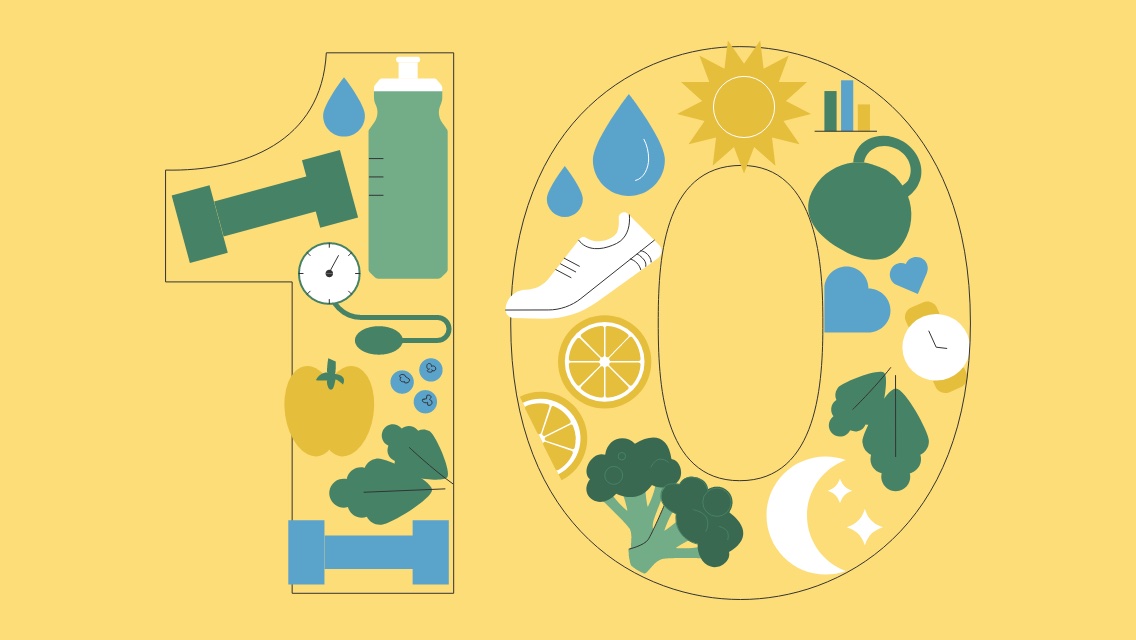A stroke is a serious medical emergency that’s often associated with paralysis or numbness in one side of the face or body and trouble speaking. It happens when blood supply is blocked from part of the brain or when a blood vessel in the brain bursts, often causing lasting damage or disability. It’s estimated that more than 795,000 people in the United States have a stroke each year, and while risk increases with age, strokes can occur at any age.
For Larry Kaddy, age 54, the day he had a stroke started off just like any other — and his symptoms felt mild and came on slowly.
Kaddy, a member concierge at Life Time in Mount Laurel, N.J., was at work checking members in at the front desk when he first started to feel “strange.”
“I didn’t feel overstressed; I felt normal,” Kaddy recalls. “Then, I felt a warm sensation and when I tried to move, I couldn’t feel my right leg at all. It felt like Jell-o, but it wasn’t numb or tingly, so I just tried to walk it off. But after about 10 minutes, I couldn’t feel it at all.”
Kaddy told his manager, who helped him decide the best course of action. “We sat for a while, and I eventually decided to call an ambulance,” he says. “In case things got worse, I wanted to be in a place where someone could help me.
“I was ticking off all the signs of a stroke that I was aware of, and I didn’t have any of them. What is going on? I remember thinking,” he continues. “Once I got to the hospital, I passed all the neurological movement tests, but once they took my blood pressure again, the situation began to escalate. My blood pressure was jumping around dramatically from low to high.”
Although the symptoms in his leg subsided, hospital staff decided to keep Kaddy in the emergency room overnight. The next day, he was able to get an MRI.
“The results came in and they saw some damage to my brain. They were officially calling it a stroke,” he recalls. “They prescribed me a blood thinner, a baby aspirin, and a few other medications. I went home that day.”
Kaddy had a few weeks of medical appointments ahead of him before he was able to get back to his normal routine.
“I wanted to run all the tests and really figure out why this happened,” he says. “We discovered my LDL cholesterol levels were elevated and my blood pressure was high. My doctor wanted to prescribe a statin, a medication that helps to reduce cholesterol.”
High blood pressure, high cholesterol, obesity, diabetes, and smoking are known leading causes of strokes.
“I had some reservations about taking a statin because both my dad and brother had bad reactions to taking one a few years before,” Kaddy remembers. “But a few weeks later, I ran into a Life Time member who told me about his experience with high LDL levels while training for bike races. He encouraged me to listen to my doctor and get on the statin.”
A Complete View of Health
As a former first responder in the U.S. Coast Guard and a certified personal trainer, Kaddy always considered himself to be relatively healthy and physically active. Since his stroke, he’s on a mission to spread the word about the importance of paying attention to your blood pressure and getting your blood lab markers checked regularly.
“You can have the best body-fat percentage, you can exercise, you can watch your nutrition — but if you know don’t your blood markers, then you only have half the picture,” he says. “I had no indication that I had high blood pressure or high cholesterol. I’m not a regular drinker. I’ve never smoked. I thought I was fine.”
Experts agree that you can’t judge a book by its cover when it comes to measuring health and wellness. “Chronic health issues and conditions don’t just happen overnight,” says Samantha McKinney, RD, CPT, Life Time master trainer and dietitian. “Subtle shifts can happen years before you might see or feel anything wrong. Knowledge is power, so the more you know about what’s going on ‘under the hood,’ the more you can take individualized steps with exercise, nutrition, and lifestyle to hopefully avoid or delay a diagnosis down the road.”
McKinney recommends that anyone over age 30 work with their healthcare provider to get an in-depth, comprehensive lab test done at least once per year as a proactive measure. This helps you monitor trends over time.
“A full panel includes the basics run at a standard physical, including blood pressure and cholesterol, as well as a closer look at nutrient status and more in-depth insights related to blood-sugar regulation, inflammation, and heart-health markers,” McKinney explains. “A look at stress hormones, sex hormones, and thyroid hormones is also important as all these measures are interconnected.” (She recommends the Life Time All-in-One lab panel, which includes all of these measures.)
Living a Healthy Way of Life
Thankfully, Kaddy has had no long-term effects from his stroke, but the experience has made him even more mindful of taking care of himself. “This was an eye-opener for me, and I want it to be an eye-opener for others,” he says. “People in my life were shocked to hear I had a stroke, so I use it as an opportunity to encourage them to take preventive actions for their health.
“The biggest change I’ve made is moving more throughout the day,” he continues. “I do a few 10-minute walks each day, usually after I’ve eaten to help pump the glucose out of my bloodstream. My blood pressure is now the lowest I’ve seen since starting this routine.
“I’m also taking a lot more classes,” he adds. “I’ve incorporated yoga for meaningful breathing as everything that I research these days is about reducing stress.”
Kaddy is incorporating more supplements and testing into his routine too. “In addition to the medication I take poststroke, I take fish oil, vitamin C , a probiotic, vitamin D with K2, zinc with quercetin, and magnesium at night to help me sleep better. I also want to do the metabolic testing available through Life Time,” he adds.
McKinney underscores that you have the biggest influence when it comes to taking care of your own health. “No one falls into optimal health by accident,” she says. “We are individually responsible for our habits and how we take care of our bodies — or don’t. We absolutely need to partner with a healthcare team, but no one is going to have a bigger impact on your health than yourself.
“For those who truly want to be proactive,” she adds, “it takes more than just the annual physical. In-depth testing paired with a knowledgeable team to interpret the results and guide you — along with self-responsibility and self-discipline — can be a major influence on the trajectory of your health, longevity, and vitality.”
As for Kaddy, he feels fortunate to not only have survived his stroke, but to have learned from it with the support of his community. “I attribute that to my way of life and the team I’ve built around me, both at Life Time and my friends and family. I wouldn’t want to be anywhere else.”
For more guidance on lab marker testing, explore these resources:









